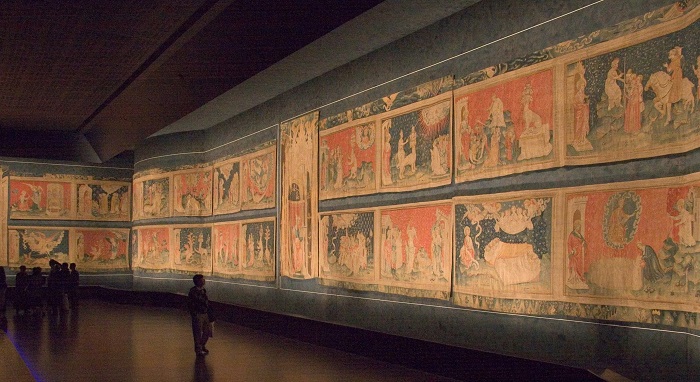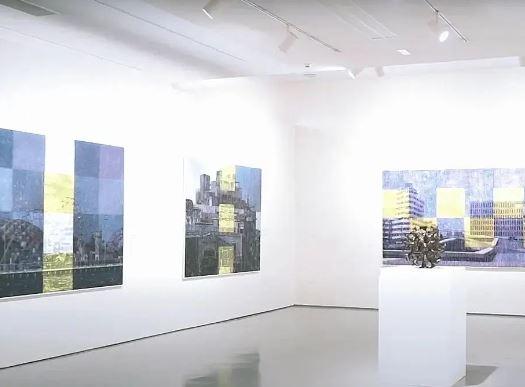The World’s 8 Most Valuable Tapestries

Tapestries are woven artworks that depict scenes, stories, or patterns, often using colourful and intricate designs. Tapestries have been produced and appreciated for centuries, across different cultures and regions. They can also be very valuable, especially if they are rare, old, or historically significant. Here are eight of the most valuable tapestries in the world, based on their auction prices or estimated values.
The Apocalypse Tapestry
The Apocalypse Tapestry is a series of tapestries that illustrate the Book of Revelation, the last book of the Bible. It was commissioned by Louis I, Duke of Anjou, in the late 14th century, and was woven by Nicolas Bataille and Robert Poinçon in Paris. The tapestry is considered a masterpiece of Gothic art and is displayed at the Château d’Angers in France. The tapestry is estimated to be worth over $200 million.
The Hunt of the Unicorn
The Hunt of the Unicorn is a series of seven tapestries that depict the mythical creature and its pursuit by hunters. It was woven in the Netherlands or France in the late 15th or early 16th century, using wool, silk, and metallic threads. The tapestry is rich in symbolism and allegory and may represent the love story of Anne of Brittany and Louis XII of France, or the Christian themes of purity and salvation. The tapestry is displayed at the Cloisters Museum in New York and is valued at $50 million.
The Lady and the Unicorn
The Lady and the Unicorn is a series of six tapestries that depict a noblewoman and a unicorn, along with a lion, a monkey, and various flowers and animals. It was woven in Flanders or France in the late 15th or early 16th century, using wool and silk. It was rediscovered in 1841 in the Château de Boussac in France and was donated to the Musée de Cluny in Paris in 1882. The tapestry is estimated to be worth $20 million.
The Bayeux Tapestry
The Bayeux Tapestry is a long embroidered cloth that narrates the events leading up to and including the Norman conquest of England in 1066. It was commissioned by Bishop Odo of Bayeux, the half-brother of William the Conqueror, in the late 11th century, and was embroidered by English or Norman women in England. It is considered a unique and invaluable source of historical and artistic information and is displayed at the Bayeux Museum in France. The tapestry is estimated to be worth $15 million.
The Valois Tapestries
The Valois Tapestries are a series of eight tapestries that depict the festivities and ceremonies of the French court under King Charles IX and his mother, Catherine de’ Medici, in the 16th century. They were woven in Brussels in the late 16th or early 17th century, using wool, silk, and gold and silver threads. The tapestry is remarkable for its vivid and detailed portrayal of the costumes, customs, and characters of the Renaissance era, and for its influence on later artists such as Peter Paul Rubens and Anthony van Dyck. It is valued at $10 million.
The Raphael Cartoons
The Raphael Cartoons are a series of seven large-scale designs by the Italian Renaissance painter Raphael, which were used as models for tapestries that were commissioned by Pope Leo X in 1515. The tapestries depict scenes from the lives of Saints Peter and Paul and were woven by Pieter van Aelst in Brussels in 1516-1521. The tapestries were hung in the Sistine Chapel in the Vatican, and are still used on special occasions. The cartoons were acquired by King Charles I of England in 1623, and are now displayed at the Victoria and Albert Museum in London. The cartoons are valued at $8 million.
The Pearl Mosque
The Pearl Mosque is a tapestry that depicts the interior of the mosque of the same name, which was built by Emperor Shah Jahan in the 17th century in the Red Fort of Delhi, India. It was woven in Isfahan, Iran, in the late 17th or early 18th century, using silk and metal threads. The tapestry is remarkable for its realism and perspective and its use of light and shade. The tapestry was owned by the Mughal emperors and was looted by the British army in 1857. The tapestry was sold at Christie’s in London in 1990 for £638,000 ($1,125,049), setting a world record for a tapestry at auction.
The Tibetan Thangka
The Tibetan Thangka is a silk tapestry that depicts the Buddha Amitayus, the Buddha of Infinite Life, surrounded by various deities and symbols. It was woven in Tibet in the 15th century, using silk, gold, and silver threads. The tapestry is considered a rare and exquisite example of Tibetan art and is one of the earliest and finest thangkas in existence. The tapestry was owned by the Qianlong Emperor of China and was later acquired by the Qinghai Provincial Museum. The tapestry was sold at Christie’s in Hong Kong in 2014 for HK$348.4 million ($45 million), setting a world record for Chinese art.




